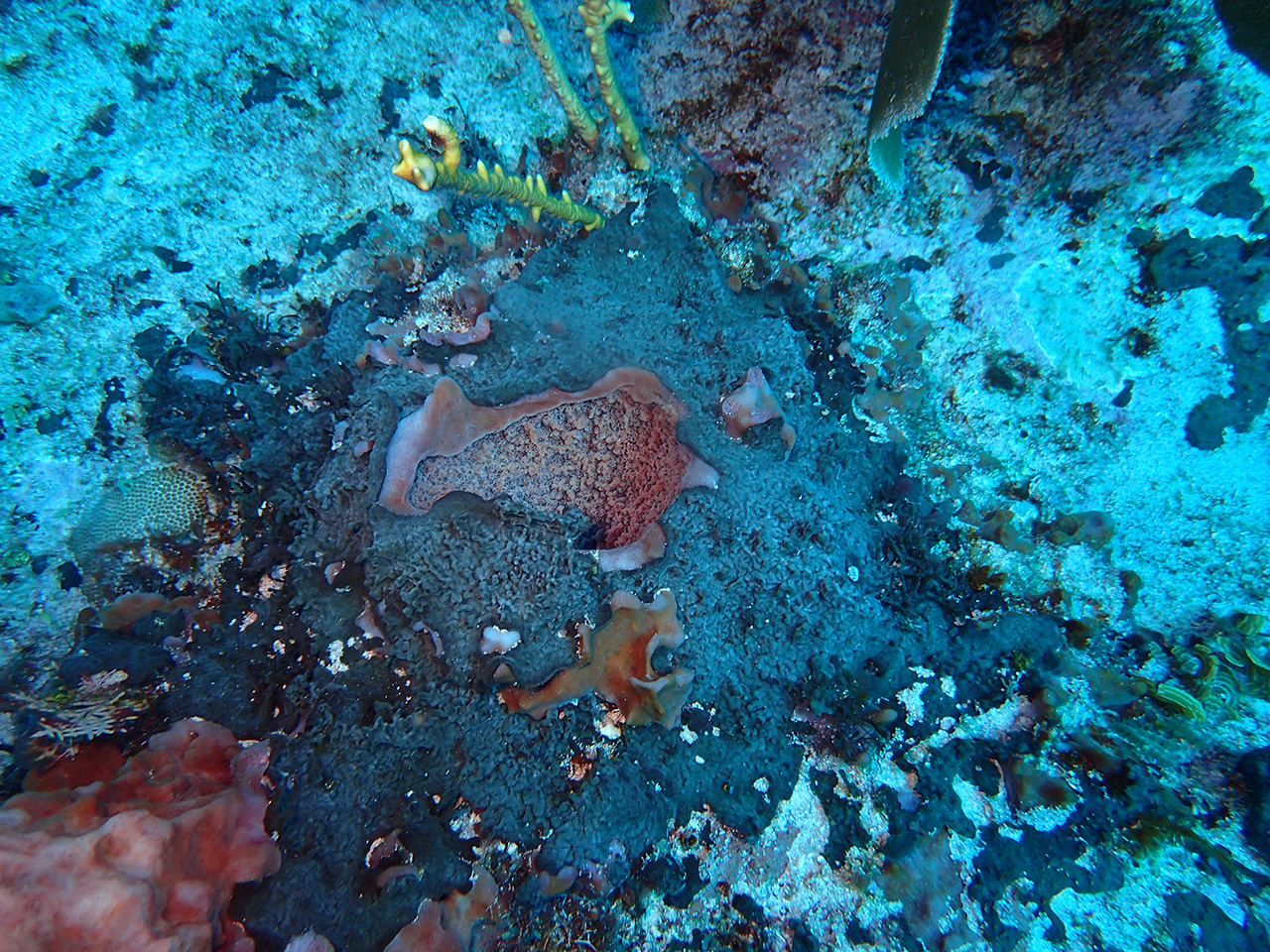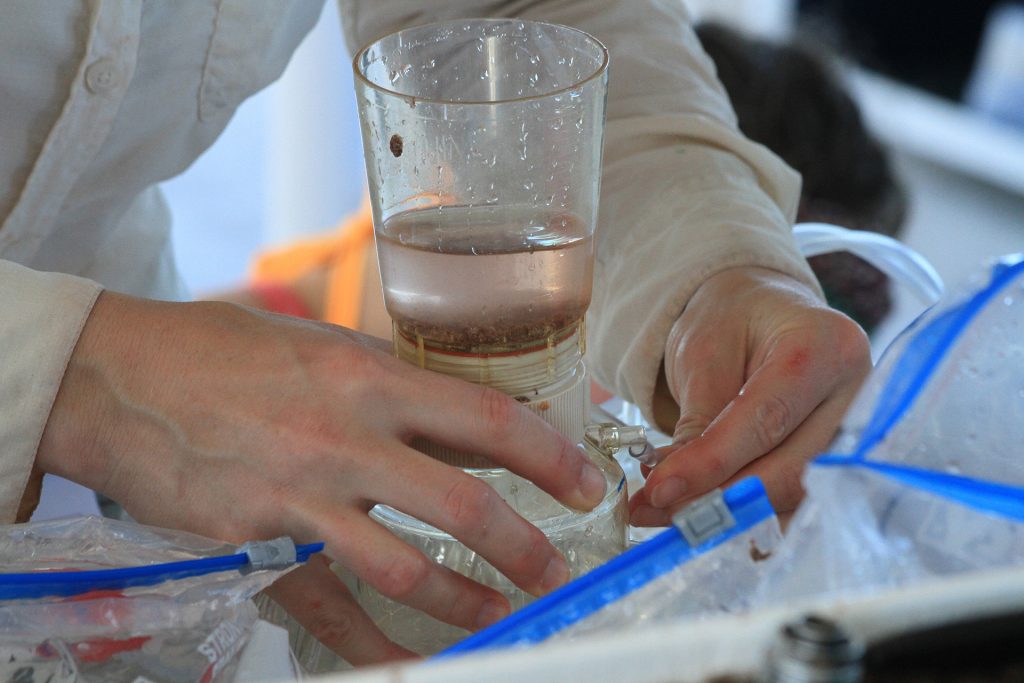Calm chaos on the Saba Bank
Day 6. Wild days
Wild days on the Saba Bank. Things you take for granted on land, are such complexities on a ship rocking on the grand Sababankian waves. Place a cup on the table – wooosh, it’ll go flying if you don’t hold on to it. Same for plates full of food. Every walk is a funny walk, as you jostle left and right with the force of the waves and an ever alert eye for flying cups and saucers.
The dives start equally wild. All kitted up in dive gear, we stand in line, walking like ducks with our fins on, boogie-woogying to the tune of the waves, and the music of Brett, the dive instructor. Brett selects music appropriate to the waves, ‘Highway to Hell’ with ominous crashing waves, ‘My baby just cares for me’ for calmer seas. One by one we’re told (or rather commandeered) to jump off the boat into the waves. ‘Go!’ Jump, splash. ‘Go!’ Splash. ‘Go!’ ‘Go!’ shout the crew. Then a swim to a red buoy, which is the starting point of our work. On days when the waves are particularly high and the current intense, the swim to the buoy can seem endless.
However, once we reach the buoy, we hit the moment we’ve been waiting for: the descent to the deep calm. Just 5m below the water, all the wildness is gone. As the bottom life becomes apparent, we slowly catch our breath. The reefs are a seascape of never-ending possible shapes and colors of sponges, corals, fans, a world from Dr. Seuss books with equally fantastic creatures residing in them. What I love about working on reefs is that you get to fly over this fairy wonderland, occasionally swimming closer to the bottom to take a peek, to photograph, to collect and then drifting back, letting the bottom life live at peace again.

Lisa takes a sample of cyanobacteria (photo: Oscar Bos)
Slow motion war
Yet, all is not as peaceful as it seems. There’s a bit of a silent, slow motion war raging. A war for territory. Corals, sponges and algae try to smother each other, exude chemicals to prevent the other from growing over each other or to kill their neighbor off so they can take over the limited ground available. Now all of this is a natural way of life, in a certain balance. Things have been changing the past decades, though. For quite some time, corals have been suffering due to the heat of the water, bleaching and disease. Algae have been taking over their territory.
And now, since a few years, we’re seeing a new player coming in, cyanobacterial mats. These fluffy red-brown mats are groups of bacteria and other micro-critters. They can cover swaths of sand, alongside corals and entangled in algae. The problem is that the mats are toxic and make it hard for little coral recruits to settle (see Miriam’s blog). We’re curious to see how algae, sponges and cyanobacteria interact, are they helping each other grow? Are they competing? We suck up the fluffy mats of cyanobacteria with large syringes (see picture), then collect algae and sponges. When we’re back in The Netherlands, we’ll do genetics to understand the microbes involved and stable isotope analysis to see who is eating what.

Syringe is filled with cyanobacteria (photo: Oscar Bos)
New sponge in town
I was surprised, there seems to be a new sponge on the Saba Bank. He’s grey, slick with crazy hair and his love smothers others to death. He’s seems unobtrusive at first. You could miss him if you didn’t know his ways. That is until he is absolutely everywhere: He’s the Killer Sponge! During this expedition we have seen it in some sites in the Saba Bank. That’s a worrying sign. In Hawaii and parts of Asia the killer sponge is taking over the reefs in disturbed areas.
Now, the killer sponge is not actually just one species. In the Pacific there are at least two least two species and this sponge in the Caribbean is likely another one. So it’s a band of smotherers with the same disguise. They are grey-greenish, they grow really fast and have some helpers to grow – they live in association with algae or cyanobacteria that take up sunlight and make food which they share with the sponge. And they smother. It’s not clear whether they are just fast growing opportunists, taking up any space that comes free. Or rather are active suffocators, encroaching the poor corals, depriving them of oxygen and food by keeping them in the dark. The killer sponge also seems to like to cling onto other sponges. We saw them draped over a large Barrel Sponge (Xestospongia muta), as if the sponge had been poored over with some kind of greyish icing.
I don’t recall seeing this sponge on Saba Bank three years ago, we’ll have to take a good look at the pictures to see what’s up.

Killer sponge on a barrel sponge (photo: Jean Phipille Marechal)
Calm Chaos
Because our dives are quite deep, before you know it we have to stop and go back up, away from the calm. We ascend slowly together, with our wonderful dive guide Kirsten who entertains us doing acrobatics on the rope while we hang for our decostop at 5m. Once your head pops up above the water, all the wildness comes back again. Waves, wind, massive boat approaching us. Kirsten huddles us together and we swim towards the boat.
Getting back on board is by no means as easy as getting in the water. We’re supposed to hold on to a rope that is tethered to a plateau at the back of the boat. With every big wave, this plateau lifts up and crashes back down in the water. You have to time the waves, to make certain the plateau doesn’t come crashing onto you when you try to grab the ladder railings. And at the same time try not to get sucked under the boat. The only reason I put up with this chaos is the competence of the crew. In particular, Brett with his marine style clarity of commandeering. He eyes the waves, eyes the boat, eyes the position of the rope that has us divers attached and decides ‘ Go, go, go, go’ or ‘HOLD!!’. He seems to have such command of the chaotic situation that we do what he says blindly and feel calm. Man, what a feat to get on though.

Diver Kirstin with acrobatic rides (photo Oscar Bos)
Hanging on to the rope, waiting while the people before you get on, being pulled which ever way as the boat and waves tug you. Fins off on your left hand and when you get the signal, as fast as you can pull yourself towards the boat on the rope. Then clamp onto the white ladder for dear life. Here Brett will catch you by the tank, and you hoists yourself up. Out of breath you climb up the rest of the ladders and plomp yourself in your seat. Whew, survived, again. Why do I do this? For the joy of the calm deep.
Mobile lab

The sample is filtered (photo: Oscar Bos)
After we catch our breath and the gear has been set away, Tobia and I jump into action to build up our mobile lab. Tray, filter, tweezer, tubes filled with pink liquids, bags, foil, pump, ziplocks. We get the lab built and deconstructed 3 times a day within a blink of an eye. While working, our reflexes are trained to catch the filter before it topples as the boat swerves, at the onset of a particularly big swell, we learn when we need to cover all the trays with our full arms and bodies to keep things from flying. Squirting cyanobacteria into filters, cutting up sponges and putting them in tubes, filtering water for bacteria. Jimmy comes by right on time when we need pumping help, he’s become very agile at pumping at any angle, moving any way when divers walk past with all their gear. Matthijs is excellent at wrapping samples in foil paper, and Didier and Alice manage to pick the perfect moments to chip in to help us finish up. With this team we can get a whale amount of work done just in time for our next dive to the calm!
Lead photo: Mat of cyanobacteria on the seabed (photo: Jean Philippe Marechal)

